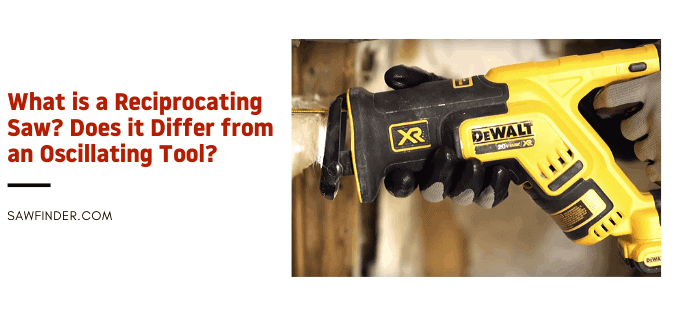When it comes to the demolition of an object, a reciprocating saw should be one of the ultimate choices. It makes cutting easier and smoother. You might choose some other stuff, including hacksaws or crowbars, but that does not give the comfort that you can enjoy with reciprocating saws. Still, you can go with the other choices, but there will be struggles and probably inaccuracy. It is why experts and professionals prefer this saw over many other demolition tools.
But what actually is a reciprocating saw? How does it even work? Is it similar to oscillating multi-tools? Going through the following writeup would help you get a clear answer to all of your questions. It’s going to be 3 to 5 minutes reading only, and you will find it is worth the time spent.
What is a Reciprocating Saw?
Commonly known as Recip Saw, though it has two other names – Sabre Saw and Hognose Saw, a reciprocating saw is a machine-powered demolition tool that is used for object demolition tasks, mostly in constructions. It is reciprocating because the saw has a Push and Pull cutting action where the blade is pushed and pulled in a motion to cut or demolish the object.
Recip saws can accept a large volume of different blades for multiple cutting purposes, including metal, plasterboard, and of course, wood! You can use them in different conditions, for instance, darker areas. Get a recip saw with LED feature for that context. There are a variety of reciprocating saws based on their features, specialties, and distinctions. You just need to grab the right one.
How Does it Work?
As said above, the blades of a recip saw acts in the push & pull method. The way is pretty much identical to that of a jigsaw. In many cases, the fitting mechanisms of both saw blades are similar. You will find many jigsaw blades a good-fit in a reciprocating saw for that reason.
Reciprocating saw motor runs and controls the movement of blades in forward-backward strokes. The blades are larger and capable of reaching awkward areas.
A handle allows the user to hold and use the saw comfortably on different surfaces, especially vertical surfaces. Typically, a reciprocating saw has an adjustable foot at the blade’s base, as you find in a jigsaw. It can be slid up or down. Users can comfortably hold the foot on the object (surface) being cut to prevent the risk of blade getting pushed away or pulled towards, as you know that the blades might get encountered while traveling through the surface.
Usually, sabre saws include a rubberized boot that helps users to grip the unit firmly. That not only helps to control the surface cut but also reduces the level of vibration that users feel while cutting.
Why Do You Need a Reciprocating Saw?
Hognose saw or whatever you call is one of the favorite demolition tools for DIY’s and professionals. If you are a professional, you know why you need one of these, and most probably you have a collection of this saw. But if you are a novice DIY or information gatherer, keep it in mind that having one of them is worth the investment.
A recip saw will assist you in many ways. Primarily, it takes over the task of demolition when your crowbar or hammer fails! It will cut and rip out the surfaces around a window, door, regardless of being wooden or metal, and cut through the plasterboards and joists efficiently. For most of the construction cutting purposes, especially while ripping out the old fittings, you will require a reciprocating saw. There are alternatives to this saw, but only the oscillating tool and jigsaw are compatible among those alternatives.
Reciprocating Saw vs. Oscillating Tool
Reciprocating saws have some similarities along with some dissimilarities when it comes to comparison with Oscillating multi-tool. We include the most significant factors about them as follows:
- Both have pretty much similar structural designs with a few exceptions. They have handles to easier handling. But reciprocating saw handles are much more comfortable to use as they are designed to be held with one hand, while the oscillating tool handles are designed to be held by both hands. But oscillating tools have a higher volume of speeds compared to reciprocating saws. Cutting precision and versatility is much more high-end for an oscillating tool than that of a reciprocating saw.
- The recip saw blades have teeth by the side, but the oscillating blades do not have such blades. While the first one works on the Push & Pull method, the later one works on the oscillation or circular method, which is much more useful for precision cutting. They are faster, smoother, and safer than that of a reciprocating saw.
- You can use hognose saws mostly for construction demolition, e.g. cutting or ripping around the door or windows. The works limited are heavy-weight in nature. On the other hand, oscillating tools can be used for multi-purpose tasks, e.g. cutting, grinding, scraping, removal of grout, grunt, and caulks, and many more. In a nutshell, oscillating tools are more versatile than reciprocating saws.
- Both have nearly identical modes of operation. The only spot where you might discover differences is discrepancies in features. But one thing is most common that you have to be careful enough while using until mastering.
- Purchasing a reciprocating saw is much more expensive than buying an oscillating tool, provided that it is only the bare tool. But when it comes to buying those with all attachments, an oscillating tool is pricer in that case.
Last Words
Despite having some dissimilarities, both cutting tools have distinctions for what they have a massive volume of continuous sales all around the world. They do the job for users and make things easier, and this is what we consider essential.

